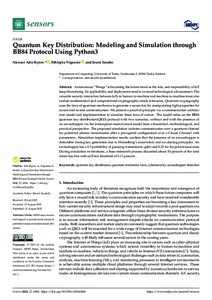Quantum Key Distribution: Modeling and Simulation through BB84 Protocol Using Python3
Adu-Kyere Akwasi; Nigussie Ethiopia; Isoaho Jouni
https://urn.fi/URN:NBN:fi-fe2022102463134
Tiivistelmä
Autonomous “Things” is becoming the future trend as the role, and responsibility of IoT keep diversifying. Its applicability and deployment need to re-stand technological advancement. The versatile security interaction between IoTs in human-to-machine and machine-to-machine must also endure mathematical and computational cryptographic attack intricacies. Quantum cryptography uses the laws of quantum mechanics to generate a secure key by manipulating light properties for secure end-to-end communication. We present a proof-of-principle via a communication architecture model and implementation to simulate these laws of nature. The model relies on the BB84 quantum key distribution (QKD) protocol with two scenarios, without and with the presence of an eavesdropper via the interception-resend attack model from a theoretical, methodological, and practical perspective. The proposed simulation initiates communication over a quantum channel for polarized photon transmission after a pre-agreed configuration over a Classic Channel with parameters. Simulation implementation results confirm that the presence of an eavesdropper is detectable during key generation due to Heisenberg’s uncertainty and no-cloning principles. An eavesdropper has a 0.5 probability of guessing transmission qubit and 0.25 for the polarization state. During simulation re-iterations, a base-mismatch process discarded about 50 percent of the total initial key bits with an Error threshold of 0.11 percent.
Kokoelmat
- Rinnakkaistallenteet [27094]
